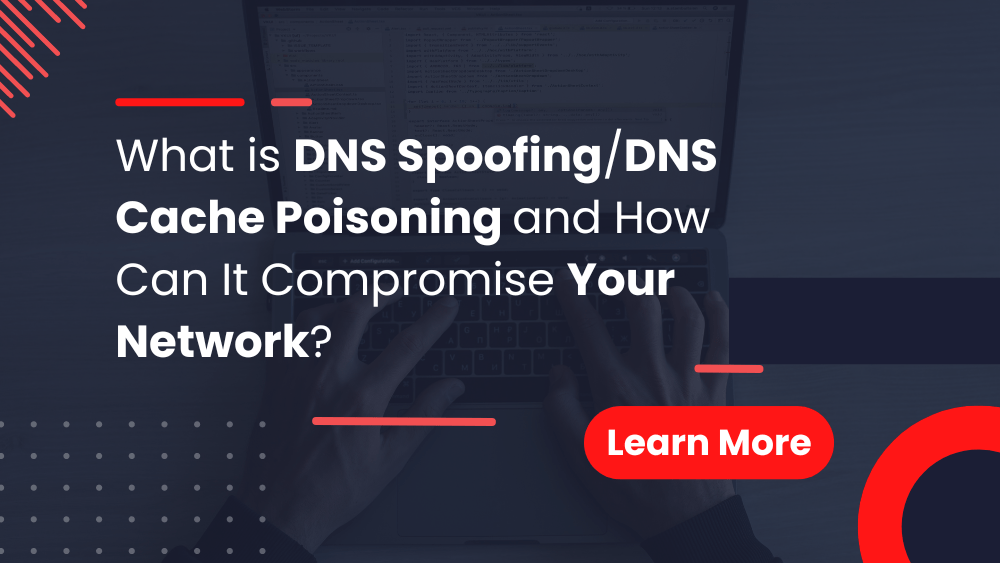Network threats are becoming increasingly sophisticated, targeting the very foundation of internet communication: the Domain Name System (DNS). DNS spoofing, also known as DNS cache poisoning, is a malicious technique that exploits vulnerabilities in the DNS system to redirect users to fraudulent websites, compromising sensitive data and disrupting critical business operations. This blog post will delve into the intricacies of DNS spoofing, its impact on enterprise networks, and essential mitigation strategies to safeguard your organization from this insidious threat.
Understanding the Domain Name System (DNS)
Before we dive into the specifics of DNS spoofing, it’s crucial to understand the fundamental role of the DNS in internet communication.
- The DNS as the Internet’s Address Book: Imagine the internet as a vast network of interconnected computers, each with a unique numerical address called an IP address. While these IP addresses are essential for communication, they are difficult for humans to remember. The DNS acts as a directory service, translating human-readable domain names (like “google.com”) into their corresponding IP addresses, making it easier for users to access websites and online services.
- How DNS Works: When you type a website address into your browser, your computer sends a request to a DNS server. This server checks its cache (a temporary storage of recently accessed information) for the corresponding IP address. If it’s not found, the server queries other DNS servers in a hierarchical structure until it finds the correct IP address. This IP address is then returned to your computer, allowing you to access the website.
What is DNS Spoofing?
DNS spoofing/DNS Cache Poisoning is a malicious technique that exploits vulnerabilities in the DNS resolution process to redirect users to fraudulent websites, often controlled by attackers. This redirection can occur at various points in the DNS hierarchy, including:
- Spoofing DNS Servers: Attackers can compromise DNS servers, either through direct attacks or by exploiting vulnerabilities, and manipulate the data they store. This allows them to provide false IP addresses for legitimate domain names, directing users to malicious websites.
- Poisoning DNS Caches: Attackers can inject false information into the DNS caches of individual computers or network devices. When a user requests a specific domain name, the poisoned cache provides the attacker’s IP address instead of the legitimate one, leading to redirection.
How DNS Spoofing Works
Here’s a step-by-step breakdown of how DNS spoofing can occur:
- Compromising a DNS Server: Attackers may exploit vulnerabilities in DNS server software or gain unauthorized access to the server’s configuration.
- Injecting False Information: Once they have control over the server, attackers can modify the DNS records, associating legitimate domain names with malicious IP addresses.
- Exploiting DNS Caches: Attackers then send crafted DNS responses to unsuspecting computers or network devices, causing them to cache the false information.
- Redirection: When a user attempts to access a legitimate website, their computer or network device retrieves the poisoned information from the cache, redirecting them to the attacker’s website.
Here’s a detailed breakdown of how DNS Cache Poisoning can occur, focusing on the two primary methods:
1. Spoofing DNS Servers:
- Exploiting Vulnerabilities: Attackers may exploit vulnerabilities in DNS server software, such as buffer overflows, SQL injection flaws, or weak authentication mechanisms. These vulnerabilities allow attackers to gain unauthorized access to the server’s configuration or inject malicious code.
- Direct Attacks: Attackers may attempt to directly compromise DNS servers through brute-force attacks, social engineering, or malware infections. These methods aim to gain control over the server’s administrative credentials or install malicious software that allows them to manipulate DNS records.
- Manipulating DNS Records: Once they have control over the server, attackers can modify the DNS records, associating legitimate domain names with malicious IP addresses. This is achieved by changing the “A” record, which maps a domain name to an IP address, or by creating new records that point to the attacker’s server.
2. Poisoning DNS Caches:
- Crafted DNS Responses: Attackers can send crafted DNS responses to unsuspecting computers or network devices, containing false information about the IP address associated with a specific domain name. These responses are designed to be accepted as legitimate by the receiving device, exploiting vulnerabilities in the DNS protocol.
- Exploiting DNS Cache Timing: Attackers can exploit the timing mechanisms of DNS resolution to inject false information into the cache. For example, they can send a series of DNS responses that arrive at the receiving device before the legitimate response, causing the device to cache the false information.
- Cache Overflow Attacks: Attackers can exploit the limited capacity of DNS caches by sending a large number of DNS requests for the same domain name. This can cause the cache to overflow and accept the attacker’s false information.
Impact of DNS Spoofing on Enterprise Networks
DNS spoofing poses significant risks to enterprise networks, potentially leading to:
- Data Breaches: Users redirected to fake websites may unwittingly provide sensitive information, such as login credentials, credit card details, or personal data, directly to attackers.
- Financial Losses: Attackers can use DNS spoofing to redirect users to fraudulent websites that mimic legitimate online stores, leading to financial losses through unauthorized purchases or fraudulent transactions.
- Disruption of Business Operations: DNS spoofing can disrupt critical business operations by redirecting users to non-functional websites or services, impacting productivity and customer satisfaction.
- Reputation Damage: DNS spoofing can damage an organization’s reputation by associating its brand with malicious activities, leading to loss of trust and customer confidence.
Real-World Examples of DNS Spoofing Attacks
DNS spoofing has been used in numerous high-profile attacks, demonstrating its potential to disrupt critical services and compromise sensitive data. These attacks highlight the real-world impact of DNS spoofing and the importance of implementing robust security measures to protect against this threat.
- The 2008 DNS Cache Poisoning Attack:
In 2008, a widespread DNS cache poisoning attack targeted the DNS servers of major institutions, including universities and government agencies. The attackers successfully poisoned the DNS caches of these institutions, redirecting users to malicious websites that mimicked legitimate services like online banking and email providers. This resulted in widespread data breaches, as unsuspecting users unwittingly provided their login credentials and other sensitive information to the attackers.
- The 2011 Google DNS Cache Poisoning Attack:
In 2011, a similar attack specifically targeted Google’s DNS servers, which were used by millions of users worldwide. The attackers injected false information into Google’s DNS caches, redirecting users to malicious websites controlled by them. This attack aimed to steal sensitive information, such as login credentials and financial data, from unsuspecting users.
- The 2016 Dyn DDoS Attack:
The 2016 Dyn DDoS Attack, while not a direct DNS spoofing attack, exploited vulnerabilities in Dyn’s DNS infrastructure, overwhelming their servers with a massive volume of traffic, effectively taking them offline. This resulted in outages for major websites like Twitter, Netflix, and Spotify, affecting millions of users worldwide.
- The 2017 Mirai Botnet Attack:
In 2017, the Mirai Botnet Attack targeted various internet-connected devices, including routers, cameras, and DVRs, to create a large botnet capable of launching DDoS attacks. The botnet was used to launch a massive DDoS attack against Dyn, causing widespread internet outages. This attack also targeted other organizations, demonstrating the potential for botnets to be used to launch DNS-related attacks.
- The 2018 Iranian Cyberattacks:
In 2018, Iranian cyberattacks targeted various organizations and individuals in the United States and other countries, including government agencies, businesses, and journalists. The attackers used DNS spoofing and other techniques to redirect users to malicious websites and steal sensitive information. This attack also aimed to disrupt critical services and sow discord among targeted individuals and organizations.
Mitigation Strategies for DNS Spoofing
Protecting your enterprise network from DNS spoofing requires a multi-layered approach, including:
- DNS Security Extensions (DNSSEC): DNSSEC is a cryptographic protocol that adds digital signatures to DNS records, ensuring their authenticity and integrity. This makes it difficult for attackers to inject false information into the DNS system.
- Secure DNS Resolver: Employing a secure DNS resolver, such as those provided by cloud providers or specialized security vendors, can help filter out malicious DNS responses and prevent redirection to fraudulent websites.
- Network Segmentation: Dividing your network into smaller, isolated segments can limit the impact of DNS spoofing by preventing attackers from spreading malicious information across the entire network.
- Firewall Protection: Implementing a robust firewall can help block malicious traffic attempting to exploit DNS vulnerabilities or inject false information into the network.
- Regular Security Updates: Keeping all network devices and software up-to-date with the latest security patches is crucial to mitigate known vulnerabilities that could be exploited by attackers.
- Employee Training: Educating employees about the risks of DNS spoofing and best practices for identifying and avoiding phishing attacks can help prevent them from falling victim to malicious schemes.
- Monitoring and Detection: Regularly monitoring network traffic for signs of DNS spoofing attacks, such as unusual DNS queries or unexpected redirects, can help identify and respond to threats promptly.
Conclusion
DNS spoofing is a serious threat to enterprise networks, potentially leading to data breaches, financial losses, and disruption of business operations. By understanding the workings of DNS spoofing and implementing appropriate mitigation strategies, organizations can effectively protect their networks and sensitive data from this insidious threat.
FAQs
1. What is the difference between DNS spoofing and DNS cache poisoning?
While often used interchangeably, there is a subtle distinction. DNS spoofing refers to the broader act of manipulating DNS responses to redirect users to malicious websites. DNS cache poisoning is a specific technique within DNS spoofing where attackers inject false information into the DNS caches of individual computers or network devices.
2. How can I tell if my network is being targeted by a DNS spoofing attack?
Several signs can indicate a DNS spoofing attack:
- Unusual DNS queries: Monitoring network traffic for unusual DNS queries, such as requests for domains that are not typically accessed by your organization, can be a red flag.
- Unexpected redirects: If users are being redirected to websites they did not intend to visit, it could be a sign of DNS spoofing.
- Slow website performance: DNS spoofing can slow down website performance as the DNS resolution process is disrupted.
- Security alerts: Your security tools, such as firewalls or intrusion detection systems, may generate alerts related to suspicious DNS activity.
3. Can DNSSEC completely prevent DNS spoofing?
While DNSSEC significantly strengthens the DNS system against spoofing attacks, it’s not a foolproof solution. Attackers can still exploit vulnerabilities in other parts of the DNS infrastructure or target devices that do not support DNSSEC.
4. Is DNS spoofing only a threat to personal computers?
No, DNS spoofing can affect any device connected to the internet, including enterprise servers, network devices, and mobile devices.
5. What are some best practices for protecting against DNS spoofing?
- Implement DNSSEC to ensure the authenticity and integrity of DNS records.
- Use a secure DNS resolver from a reputable provider.
- Keep all network devices and software up-to-date with the latest security patches.
- Educate employees about the risks of DNS spoofing and how to identify phishing attacks.
- Monitor network traffic for signs of suspicious DNS activity.
6. What should I do if I suspect my network is being targeted by a DNS spoofing attack?
If you suspect a DNS spoofing attack, take the following steps:
- Isolate the affected devices: Disconnect any devices that may have been compromised from the network.
- Contact your security team: Report the incident to your security team or a qualified cybersecurity professional.
- Review your security logs: Analyze your security logs for any suspicious activity related to DNS traffic.
- Update your security measures: Implement or strengthen your existing security measures, such as DNSSEC, secure DNS resolvers, and network segmentation.
7. What are some common tools used for DNS spoofing attacks?
Attackers use various tools for DNS spoofing, including:
- DNS cache poisoning tools: These tools can be used to inject false information into DNS caches.
- DNS server exploitation tools: These tools can be used to compromise DNS servers and manipulate their data.
- Network scanning tools: These tools can be used to identify vulnerable DNS servers and devices.
8. How can I stay informed about the latest DNS spoofing threats?
- Subscribe to security newsletters: Sign up for security newsletters from reputable cybersecurity organizations.
- Follow security blogs and forums: Stay up-to-date on the latest security threats by following security blogs and forums.
- Attend security conferences: Participate in security conferences to learn about the latest trends and best practices.









